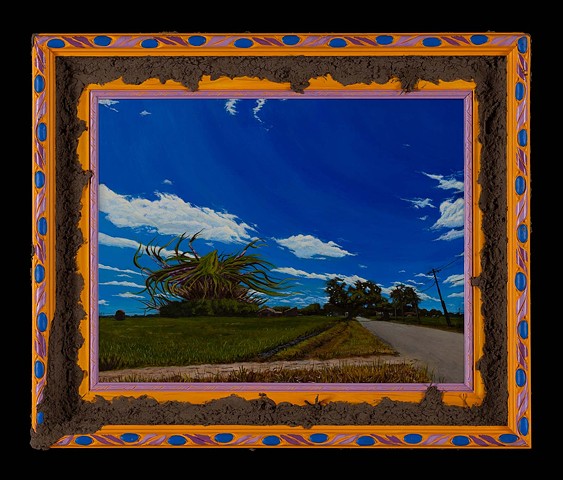Nostalji ki fé rékòt
Bagas en lè: Smithfield
Lontem pasé navé in nabitasyon disik dan laparwas Wès Baton-Rouj pélé Smithfield. Yé té batí li pendan Rékonstriksyon é té engajé moun pou travayé dan dézè, péyé yé in ti salèr. Dékònn té dous dous, plin koulè, byin réyé. Çé té sitan bon pou manjé, dékònn-çala pélé riban vyolé. Navé moun dan mô famiy ki té rété é travayé koté nabitsyon-la. Mô granpopa, Alton, é mô granmoman, Gladis, té fé lalézon, té ramasé otan pou souchin yê famiy avan yé, yé viní ensemb.(1) Pa tro lwin yê lékòl – Devall – nabitasyon-çala té jété lésens ki remplí lè. Çé té byin fòr.
Bagas en lè parlé ségré apré ça ina ki grosi dan bwa.
Travayan-layé pa konnin komen régardan é méshan yê gro bòs té viní. Li arété péyé moun pendan kèk smènn é konmensé ashté zafè pou li-minm. Min, in jou yé wá li sòti dan bwa avék kèk pyé dékònn dan sô bra. Kan li rivé bæk koté yê kabònn, li tombé jish akoté pwi-la. In travayan proshé li pou wa si li té byin. Gro bòs té pliyé en dé enho latè ê kriyé en silens.(2) In morso sô koté té manké, mé li pa sanglé. In siflé té shapé sô poumon. Avan yé viní konnin ça ki té rivé, sô namm té gònn.
Bagas en lè parlé ségré apré ça ina ki grosi dan bwa.
Lamansh Pourciau é shinmin Ashland té formin in bariyè dèryè bwa-la. Mô granparen-yé té konnin kouri jwé laba kan yé té prenn yê pòz.(3) Mô granpopa té konnin shasé kayman dan lak Clause, ça fé li té pa pè apré ça ki rété dan bwa enho nabitasyon-la. Kan yé t’ê marshé dan bwa, mô granmoman wá kèk joli shèv-féy jònn. Yé prenn dé-trò minit pou gouté in ti trit. Ê tournin, yé té marshé enho kishò. Çé té dékònn k’ê grosi jish akoté zérons. Yé dé gaddé enba pou wa in kalité kròsh yé janmin konnin avan – kanminm ça gaddé pròsh paréy riban vyolé. Yé té prenn in pyé dou dan shakin yê lamin, yé souriyé, trinké, é konmensé shiké. “ZIRAB!” yé dé hélé ê kité tombé shak pyès ki sanglé.
Bagas en lè parlé ségré apré ça ina ki grosi dan bwa.
Ça té pasé ina katrévin nan, pétèt plis mo kwa. Mô granparen-yé té ja mourí avan mo kourí wa ça inavé laba. Yé janmin parlé apré ki flavœr yé gouté. Yé janmin parlé apré kofé yé kontinnwé sòti dan bwa shak fwa yé té gin lokazyon. Yé janmin parlé. Janmin parlé. Ça mo trouvé té pa jistemen bandonnin. Pendan lajounnin, lè té jolimen léjé déyò.
Bagas en lè té pi parlé ségré enkò.
___
1. Gladis: manyè kréyolizé pou ékri Gladys.
2. ê: in markè avan væb-yé ki indiké in aksyon en progré; sèrvi konm “apé” ou “ap” dan “y’apé”. Li prononsé paréy “é”. Trouvé en tradisyon dan laparwas Lapwint-Koupé.
3. shinmin: ènn manyè nazal pou di shmin, shemin, shémin.
Flying Bagasse: Smithfield
A long time ago there was a sugar plantation in West Baton Rouge Parish called Smithfield. Built during Reconstruction, it employed people to work the fields, paying them a small salary. The sugarcane was sweet sweet, full of color, a striped treat. That sugarcane, purple ribbon, was so so good to eat. Some folks in my family lived and worked there – my grandfather, Alton, and my grandmother, Gladys, harvested cane, gathered so much to support their families before they, too, became one. Not too far from their school – Devall – that plantation released a smell that filled the air. It was really strong.
Flying bagasse whispers about what grows in the woods.
The workers didn’t know how greedy and mean their boss had become. He stopped paying people for some weeks and began to buy himself things. One day they saw him go into the woods with some sugarcane stalks. When he came back to their cabin, he fell right next to a well. One worker approached him to make sure he was okay. The big boss was folded in two on the ground, crying in silence. A portion of his ribs were missing, but he wasn’t bleeding. A whistle escaped his lungs. Before they knew what had happened, his soul was gone.
Flying bagasse whispers about what grows in the woods.
Pourciau Lane and Ashland Road formed a barrier behind the woods. My grandparents would go play over there when they took breaks. My grandfather hunted alligators in Lake Clause, so he wasn’t afraid of what lived in the woods on the plantation. When they were walking in the woods, my grandmother saw some beautiful yellow honeysuckles. They took a minute or two to taste a little treat. Turning around, they stepped on something. It was sugarcane growing just beside some bushes. They both looked down to see a gnarled and twisted type that they had never seen before – even still, it closely resembled purple ribbon. They took one sweet stalk in each of their hands, they smiled, toasted, and began to chew. “DISGUSTING!” they both yelled as they dropped each bleeding morsel.
Flying bagasse whispers about what grows in the woods.
That happened eighty years ago, perhaps more I believe. My grandparents had already passed before I went out there to see what I could see. They never spoke about the flavor they tasted. They never spoke about why they continued to go into the woods each time they had the opportunity. They never spoke. Never spoke. What I found was not necessarily abandoned. During the day, the air was light as a feather.
Flying bagasse whispered no more.
Image credit: Kevin Duffy.
Private collection.
Çé sèlmen posib fé kopi apré tèks é pòrtré si lartis-la donnin pèmisyon ékrí.
No text or images from this site may be reproduced without express written permission of the artist.
